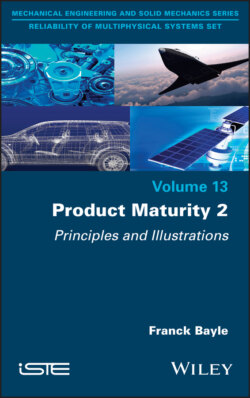Product Maturity, Volume 2

Реклама. ООО «ЛитРес», ИНН: 7719571260.
Оглавление
Franck Bayle. Product Maturity, Volume 2
Table of Contents
List of Illustrations
List of Tables
Guide
Pages
Product Maturity 2. Principles and Illustrations
Foreword by Laurent Denis
Foreword by Serge Zaninotti
Acknowledgements
Introduction
1. Sampling in Manufacturing
1.1. Cost aspects
1.2. Considering the distribution of defects
1.3. Considering the test coverage
2. Compliance Test
3. Non-Regression Tests
3.1. Non-regression on a physical quantity
3.2. Non-regression depending on time
4. Zero-Failure Reliability Demonstration. 4.1. Purpose of zero-failure tests
4.2. Theoretical principle
4.2.1. Non-maintained products
4.2.2. Maintained products
4.2.3. Estimation of parameter β
4.2.4. Physical laws of failure
4.2.4.1. Parameter of the Arrhenius law
4.2.4.2. Parameters of the Coffin–Manson law
4.3. Optimization of test costs
4.4. Specific cases
4.4.1. Imposed number of parts
4.4.2. Imposed testing time
4.4.3. Imposed testing time and number of parts
4.4.4. A test was already conducted and the demonstrated reliability should be estimated
4.4.5. One test was already conducted and failure to demonstrate reliability must be known
4.4.6. Two tests were conducted. 4.4.6.1. Testing conditions are identical for both tests
4.4.6.2. Testing conditions differ for the two tests
4.4.7. A second test is conducted
4.4.7.1. Testing conditions similar to the first test are maintained
4.4.7.2. Similar conditions to the first test, with additional new parts
4.4.7.3. The conditions of the first test are changed, the parts are the same
4.4.7.4. The conditions of the first test are changed with the same parts and new parts are added
4.4.7.5. The same testing conditions are maintained for the second test
4.4.8. Reliability objective is a failure rate
4.4.9. Reliability data are available from the manufacturer
4.4.9.1. Manufacturer data
4.4.9.2. Standard data
4.4.10. Demonstration of reliability at the product level
4.4.11. Taking into account a complex life profile
4.4.11.1. The thermal time constant is small compared to the stage duration
4.4.11.2. Thermal time constant is not negligible
5. Reliability Management. 5.1. Context
5.2. Physical architecture division
5.3. Classification of subsets
5.4. Allocation of initial reliability
5.5. Estimation of the reliability of subsets
5.5.1. Consistency with the experience feedback
5.5.2. Estimation of the power of the test
5.5.3. Simulation algorithm
5.6. Optimal allocation of the reliability of subsets
5.7. Illustration
5.8. Definition of design rules
5.9. Construction of a global predicted reliability model with several manufacturers
6. Confirmation of Maturity
6.1. Internal data from equipment manufacturer
Test cone
6.2. System manufacturer data. 6.2.1. Original fit removal rate or “zero hour returns”
6.3. End-customer data. 6.3.1. Burn-in effectiveness
6.3.2. First failure analysis
6.3.3. Method based on failure analysis
6.3.4. Observed reliability
6.3.5. Estimation of the forecasting number of catastrophic failures
6.4. Burn-in optimization
6.4.1. Distribution of failures observed during HASS cycles
6.4.2. Verification of the degradation of the manufacturing process
List of Notations
List of Definitions. A
B
C
D
E
F
L
M
N
O
P
Q
R
S
T
List of Acronyms
References
Index. A, C
D, F
G, H
L, M
N, P
R, S
T, W, Z
WILEY END USER LICENSE AGREEMENT
Отрывок из книги
Reliability of Multiphysical Systems Set
.....
Franck Bayle is a perfect example of this. Throughout the second part of his career as an electronics engineer, he relentlessly addressed challenges that no one had previously openly solved, and he developed algorithmic solutions based on cutting edge theories. He was nevertheless confronted with the ills that plague most large groups: habit and fear of change. When he proposed significant advances across the whole company, only his more informed colleagues considered these to be opportunities for improvement. Sometimes his work was considered useless by those whose feeling was: “Why consider risks when there are no problems on the ground?”. This is reminiscent of: “Why would I get sick when I am fit and healthy?”. We have to be forward thinkers to be able to act before any problem arises, and Franck Bayle is such a person. His book presents all the best practices he has managed to implement within his department, as well as all the advances that I have had the chance to see implemented, which he continues to improve.
This book is essential reading for any passionate reliability engineer, and it is a real pleasure and an honor to write this foreword to accompany it.
.....